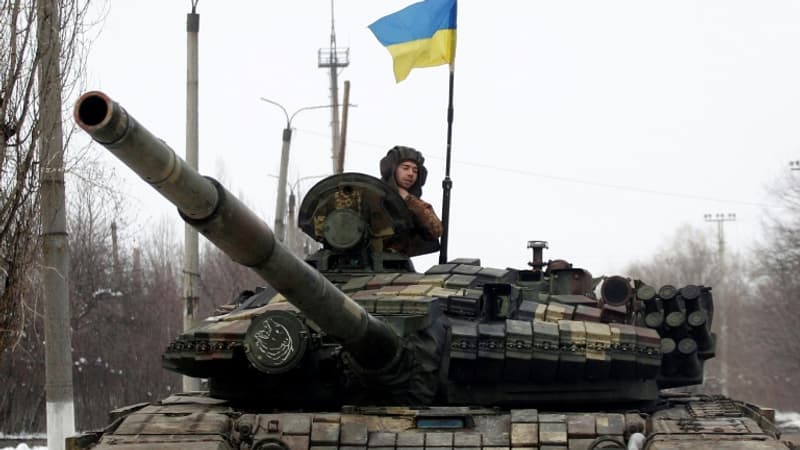Recent deliveries to Kiev of Western tanks and long-range rockets illustrate how the West is adapting to Ukraine’s needs and battlefield developments since the Russian invasion in February 2022. A look back at material deliveries to Ukraine for almost 15 months.
• Light weapons, the first sent to the field
On February 24, 2022, Russian President Vladimir Putin launched the invasion of Ukraine. Russian troops are advancing rapidly from the east and trying to encircle kyiv.
Quickly, the Ukrainians benefited from the first deliveries of arms from the West. Between February and March 2022, they receive more than 40,000 light weapons, 17,000 manpads -portable ground-air defense systems- as well as equipment (25,000 helmets, 30,000 bulletproof vests), according to data from the Kiel Institute that has identified since the beginning of the war the weapons promised and delivered to Ukraine.
In an emergency, these light weapons and equipment are easy to deliver, pick up, and move across the battlefield. No further figures have been released after this first wave of deliveries, but it’s a safe bet that deliveries have continued thus far.
• Howitzers and rocket launchers, including about thirty Caesar guns
Faced with fierce resistance in kyiv and Kharkiv, the country’s second largest city, the Russian army withdrew at the end of March 2022 to concentrate its efforts on the Donbass and southern territories. Artillery shipments began in April (howitzers, rocket launchers, etc.), capable of attacking behind enemy lines to reach ammunition reserves and block Russian logistics chains.
321 howitzers, including thirty French Caesar guns (including 19 Danish), 120 infantry vehicles, 49 multiple rocket launchers, 24 combat helicopters, more than 1000 American drones, are delivered until the fall.
• Ground-to-air defense delivered in particular by the Americans
Despite its withdrawal, Russia is launching waves of air strikes (kamikaze missiles and drones) on energy infrastructure, urban centers, far beyond the front lines. To help the Ukrainians deal with it, Western countries are handing over missile defense systems, led by the United States, the United Kingdom and Spain. Washington ends up agreeing to hand over its very famous Patriot medium-range surface-to-air missile system.
• More than 200 tanks and light armored vehicles
Since the end of 2022, a trench warfare has taken hold in the east and Ukraine fears a major Russian offensive with the arrival of recruits. 280 Soviet-made tanks that the Ukrainian army is used to using are shipped mainly from Poland. kyiv, which had only Soviet-made tanks, had lost many.
The Ukrainian president insists on getting heavy and modern Western tanks, long demanded to seize the initiative and get out of the war of attrition. She gets them. Several Western countries promise to deliver them by the end of January: Washington announces Abrams tanks (however, they will not be available before autumn 2023), London Challenger 2, Berlin Leopard 2, considered among the best in the world. The German green light also allows other countries to promise Leopard 2.
• Supersonic and long-range missiles
In January 2023, kyiv asked its allies to provide it with rockets and missiles with a range of more than 100 kilometers. Until then, they had effective systems, but less far-reaching, such as the formidable American HIMARS systems (range 80 kilometers) or its French equivalent, unitary rocket launchers (LRU) that reach around 70 kilometers. France also sent Crotales, medium-range anti-aircraft equipment.
France and Italy jointly provided a Mamba SAMP-T (Thales) system equipped with Aster-30 Medium Range Missiles (MBDA). Designed to deal with missile attacks (cruise or ballistic), attack fighter planes or drones, the Mamba is a supersonic weapon (mach 4.5) capable of reaching a target more than 100 km away.
The Ukrainian army now has rockets (150 kilometers) which, according to Russian claims not denied by Kyiv, were provided by the United States.
The United Kingdom has announced the shipment of Storm Shadow missiles, which can hit more than 250 kilometers. Ukraine considers these munitions crucial to carry out its counter-offensive and threaten Russian positions far behind the front lines.
• And tomorrow, fighter planes?
As this counteroffensive takes shape, Ukrainian President Volodymyr Zelensky expands his arsenal during a European tour: London, where he is on Monday, promises him hundreds of anti-aircraft missiles and attack drones, armored vehicles and light tanks from Paris, and Berlin a new military aid plan of 2,700 million euros.
Last February, kyiv revealed its ambition to form two squadrons of 12 fighter jets, for a total of 24 aircraft. Poland and Slovakia have decided to provide MiG-29s, but to defend the Ukrainian skies, Volodimyr Zelensky asks above all for modern combat aircraft, such as Rafales, Eurofghters, Tornadoes or F-16s.
Olaf Scholz responded firmly that “the question of combat aircraft does not even arise.” It’s a “no!” for Joe Biden, who encourages NATO countries with Russian planes to deliver them to kyiv. British Prime Minister Rishi Sunnak is on the same page as Washington in not opposing other states sending them.
In France, the position is more nuanced. Asked about this possibility during a trip to the Netherlands last February, Emmanuel Macron cautiously replied that “nothing is prohibited in principle.” The French president has banned the Rafales, but not the Mirage 2000, which is being phased out of French units undergoing modernization.
The “air military personnel” of the Ukrainian army have been trained in Mont-de-Marsan and Nancy by the Air and Space Force. These crews received training “in ground-air defense and survival in the event that their aircraft is shot down,” said the Deputy Delegate for Defense Information and Communication, General Yann Gravethe.
Source: BFM TV


